Management and Operations Report
VerifiedAdded on 2020/12/30
|17
|5100
|194
Report
AI Summary
This report analyzes Toyota's management and operations, exploring the roles of leadership and management, key operational functions, and external factors impacting decision-making. It also provides recommendations for improving operational efficiency and achieving business objectives.
Contribute Materials
Your contribution can guide someone’s learning journey. Share your
documents today.
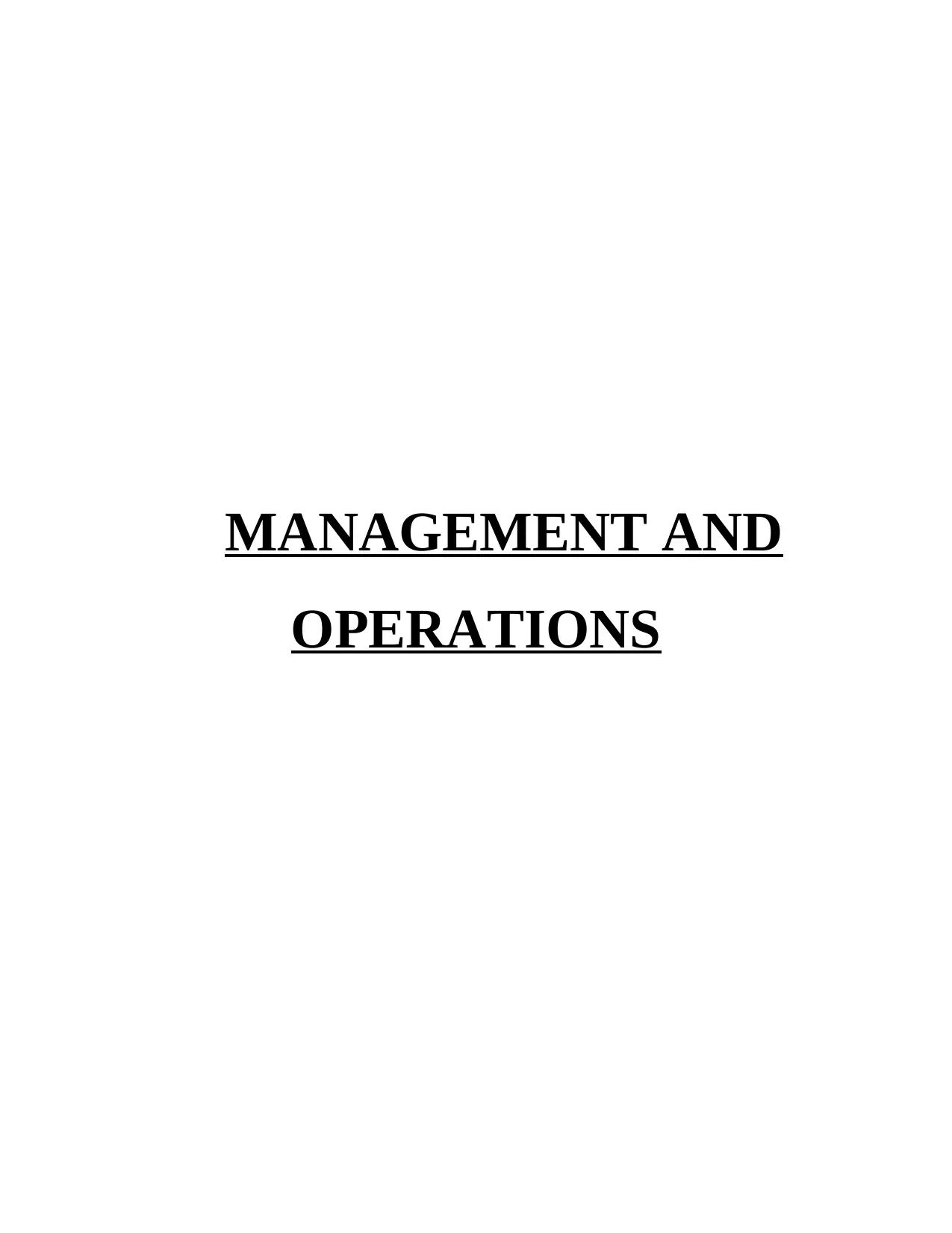
MANAGEMENT AND
OPERATIONS
OPERATIONS
Secure Best Marks with AI Grader
Need help grading? Try our AI Grader for instant feedback on your assignments.
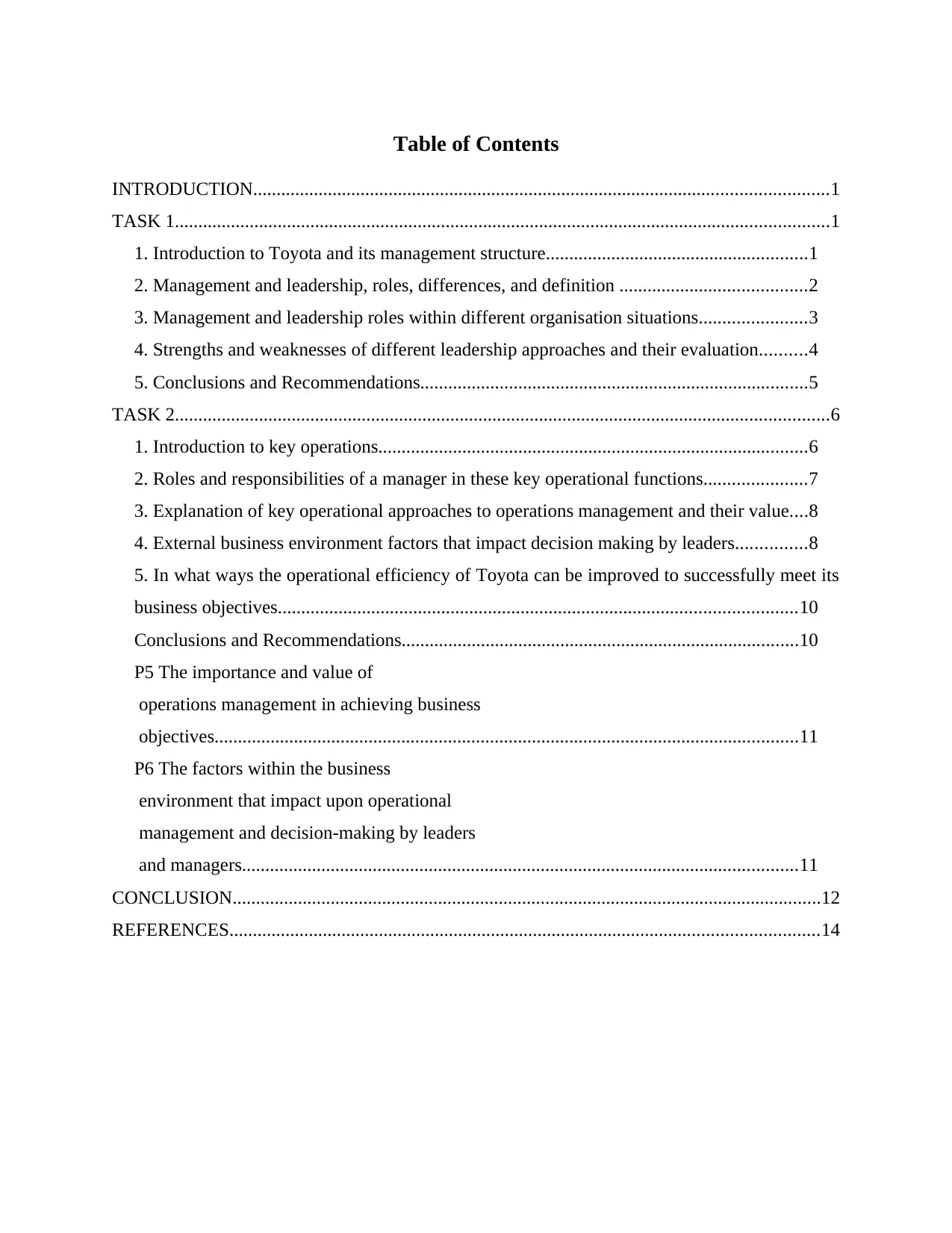
Table of Contents
INTRODUCTION...........................................................................................................................1
TASK 1............................................................................................................................................1
1. Introduction to Toyota and its management structure........................................................1
2. Management and leadership, roles, differences, and definition ........................................2
3. Management and leadership roles within different organisation situations.......................3
4. Strengths and weaknesses of different leadership approaches and their evaluation..........4
5. Conclusions and Recommendations...................................................................................5
TASK 2............................................................................................................................................6
1. Introduction to key operations............................................................................................6
2. Roles and responsibilities of a manager in these key operational functions......................7
3. Explanation of key operational approaches to operations management and their value....8
4. External business environment factors that impact decision making by leaders...............8
5. In what ways the operational efficiency of Toyota can be improved to successfully meet its
business objectives...............................................................................................................10
Conclusions and Recommendations.....................................................................................10
P5 The importance and value of
operations management in achieving business
objectives.............................................................................................................................11
P6 The factors within the business
environment that impact upon operational
management and decision-making by leaders
and managers.......................................................................................................................11
CONCLUSION..............................................................................................................................12
REFERENCES..............................................................................................................................14
INTRODUCTION...........................................................................................................................1
TASK 1............................................................................................................................................1
1. Introduction to Toyota and its management structure........................................................1
2. Management and leadership, roles, differences, and definition ........................................2
3. Management and leadership roles within different organisation situations.......................3
4. Strengths and weaknesses of different leadership approaches and their evaluation..........4
5. Conclusions and Recommendations...................................................................................5
TASK 2............................................................................................................................................6
1. Introduction to key operations............................................................................................6
2. Roles and responsibilities of a manager in these key operational functions......................7
3. Explanation of key operational approaches to operations management and their value....8
4. External business environment factors that impact decision making by leaders...............8
5. In what ways the operational efficiency of Toyota can be improved to successfully meet its
business objectives...............................................................................................................10
Conclusions and Recommendations.....................................................................................10
P5 The importance and value of
operations management in achieving business
objectives.............................................................................................................................11
P6 The factors within the business
environment that impact upon operational
management and decision-making by leaders
and managers.......................................................................................................................11
CONCLUSION..............................................................................................................................12
REFERENCES..............................................................................................................................14


INTRODUCTION
Both management and operations plays an important role in an organisation. A successful
business environment is helpful in growth and development of business. The below report
explores the business environment and operations of Toyota. Toyota is a Japanese international
car manufacturer. The organisation's corporate structure holds 364,445 employees. The report
explores roles of leader and manager. Furthermore, study explains differences between both
leadership and management. The evaluation of strengths and weaknesses of different approaches
to leadership and management are showcased in the report as well. Along with it, the report
briefly discusses the key operations, its functions, operational efficiencies and the approaches of
leadership and management used in Toyota (Jacobs, Chase, and Lummus, 2014).
TASK 1
1. Introduction to Toyota and its management structure
Toyota is a Japanese car manufacturer headquartered in Toyota City, Aichi, Japan. The
corporate structure of Toyota consists of 364,445 employees all across globe. Toyota company is
said to be the sixth largest company and second-largest automotive manufacturer in the world.
Along with it, it was the world's first auto mobile manufacturer that is producing more than 10
million vehicles per year, since 2012. The company is a leader in sales of hybrid electric vehicles
and is known as one of top auto mobile selling brands worldwide.
The management or organisational structure of Toyota is Divisional Structure. In
divisional structure the company organises its activities of business around market, geographical,
service and product groups (Alderton and Saieva, 2017). Toyota in its divisional structure has
split its employees into segments which correspond to services, products or markets. Below
explained is management (divisional) structure of Toyota:
The organisation's management structure has the following main characteristics:
1. Global hierarchy
2. Geographic divisions
3. Product based divisions
Global Hierarchy: In its current organisational structure, Toyota has allotted its decision-
making power to its unit heads and regional heads. The decision making process of Toyota is
1
Both management and operations plays an important role in an organisation. A successful
business environment is helpful in growth and development of business. The below report
explores the business environment and operations of Toyota. Toyota is a Japanese international
car manufacturer. The organisation's corporate structure holds 364,445 employees. The report
explores roles of leader and manager. Furthermore, study explains differences between both
leadership and management. The evaluation of strengths and weaknesses of different approaches
to leadership and management are showcased in the report as well. Along with it, the report
briefly discusses the key operations, its functions, operational efficiencies and the approaches of
leadership and management used in Toyota (Jacobs, Chase, and Lummus, 2014).
TASK 1
1. Introduction to Toyota and its management structure
Toyota is a Japanese car manufacturer headquartered in Toyota City, Aichi, Japan. The
corporate structure of Toyota consists of 364,445 employees all across globe. Toyota company is
said to be the sixth largest company and second-largest automotive manufacturer in the world.
Along with it, it was the world's first auto mobile manufacturer that is producing more than 10
million vehicles per year, since 2012. The company is a leader in sales of hybrid electric vehicles
and is known as one of top auto mobile selling brands worldwide.
The management or organisational structure of Toyota is Divisional Structure. In
divisional structure the company organises its activities of business around market, geographical,
service and product groups (Alderton and Saieva, 2017). Toyota in its divisional structure has
split its employees into segments which correspond to services, products or markets. Below
explained is management (divisional) structure of Toyota:
The organisation's management structure has the following main characteristics:
1. Global hierarchy
2. Geographic divisions
3. Product based divisions
Global Hierarchy: In its current organisational structure, Toyota has allotted its decision-
making power to its unit heads and regional heads. The decision making process of Toyota is
1
Secure Best Marks with AI Grader
Need help grading? Try our AI Grader for instant feedback on your assignments.
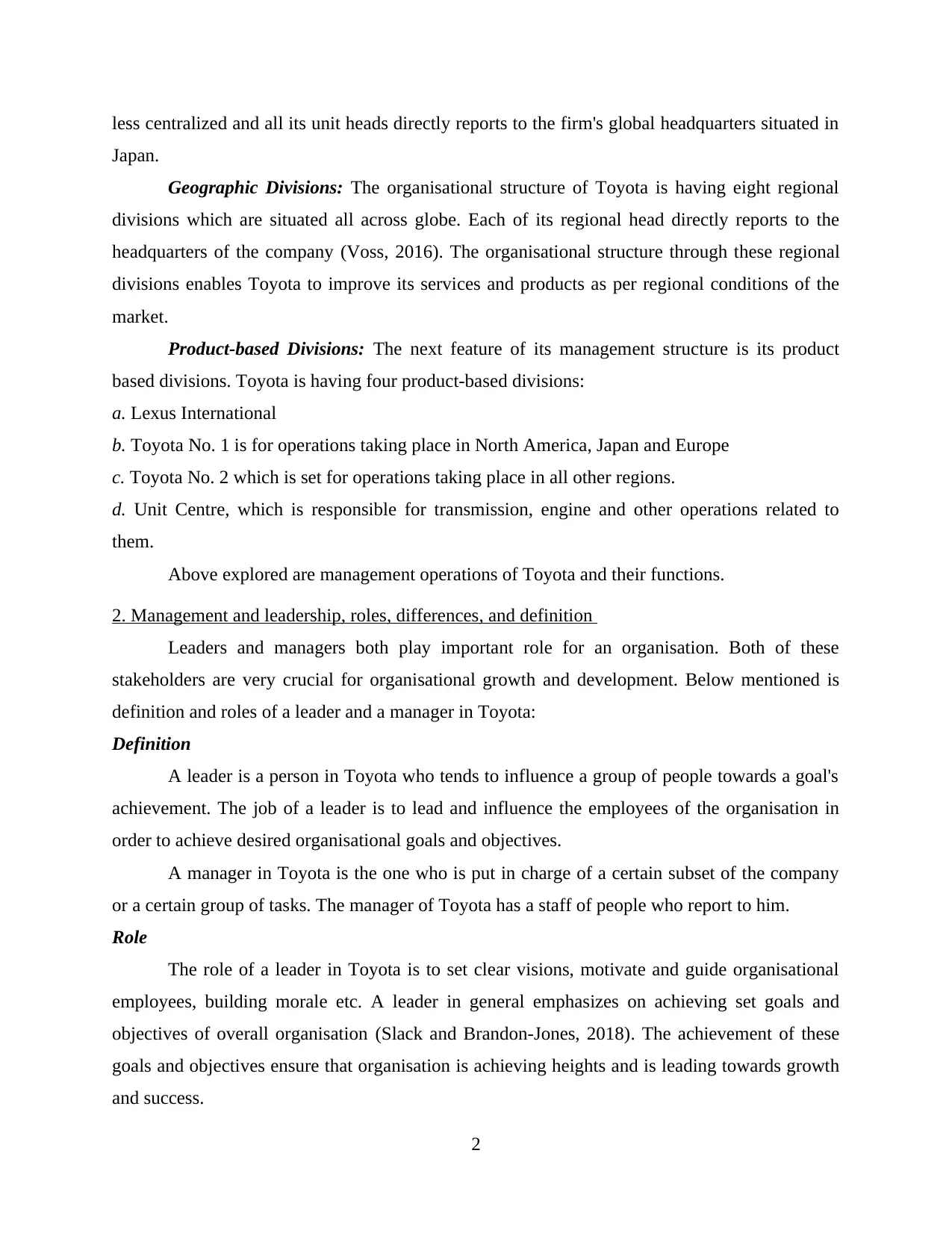
less centralized and all its unit heads directly reports to the firm's global headquarters situated in
Japan.
Geographic Divisions: The organisational structure of Toyota is having eight regional
divisions which are situated all across globe. Each of its regional head directly reports to the
headquarters of the company (Voss, 2016). The organisational structure through these regional
divisions enables Toyota to improve its services and products as per regional conditions of the
market.
Product-based Divisions: The next feature of its management structure is its product
based divisions. Toyota is having four product-based divisions:
a. Lexus International
b. Toyota No. 1 is for operations taking place in North America, Japan and Europe
c. Toyota No. 2 which is set for operations taking place in all other regions.
d. Unit Centre, which is responsible for transmission, engine and other operations related to
them.
Above explored are management operations of Toyota and their functions.
2. Management and leadership, roles, differences, and definition
Leaders and managers both play important role for an organisation. Both of these
stakeholders are very crucial for organisational growth and development. Below mentioned is
definition and roles of a leader and a manager in Toyota:
Definition
A leader is a person in Toyota who tends to influence a group of people towards a goal's
achievement. The job of a leader is to lead and influence the employees of the organisation in
order to achieve desired organisational goals and objectives.
A manager in Toyota is the one who is put in charge of a certain subset of the company
or a certain group of tasks. The manager of Toyota has a staff of people who report to him.
Role
The role of a leader in Toyota is to set clear visions, motivate and guide organisational
employees, building morale etc. A leader in general emphasizes on achieving set goals and
objectives of overall organisation (Slack and Brandon-Jones, 2018). The achievement of these
goals and objectives ensure that organisation is achieving heights and is leading towards growth
and success.
2
Japan.
Geographic Divisions: The organisational structure of Toyota is having eight regional
divisions which are situated all across globe. Each of its regional head directly reports to the
headquarters of the company (Voss, 2016). The organisational structure through these regional
divisions enables Toyota to improve its services and products as per regional conditions of the
market.
Product-based Divisions: The next feature of its management structure is its product
based divisions. Toyota is having four product-based divisions:
a. Lexus International
b. Toyota No. 1 is for operations taking place in North America, Japan and Europe
c. Toyota No. 2 which is set for operations taking place in all other regions.
d. Unit Centre, which is responsible for transmission, engine and other operations related to
them.
Above explored are management operations of Toyota and their functions.
2. Management and leadership, roles, differences, and definition
Leaders and managers both play important role for an organisation. Both of these
stakeholders are very crucial for organisational growth and development. Below mentioned is
definition and roles of a leader and a manager in Toyota:
Definition
A leader is a person in Toyota who tends to influence a group of people towards a goal's
achievement. The job of a leader is to lead and influence the employees of the organisation in
order to achieve desired organisational goals and objectives.
A manager in Toyota is the one who is put in charge of a certain subset of the company
or a certain group of tasks. The manager of Toyota has a staff of people who report to him.
Role
The role of a leader in Toyota is to set clear visions, motivate and guide organisational
employees, building morale etc. A leader in general emphasizes on achieving set goals and
objectives of overall organisation (Slack and Brandon-Jones, 2018). The achievement of these
goals and objectives ensure that organisation is achieving heights and is leading towards growth
and success.
2

The role of a manager in Toyota is to ensure proper management within the
establishment. The manager of Toyota tends to develop reports based as per needs and
requirements of the establishments employees, production, sales, customer relations etc. Along
with it, a manager also guides and trains its organisations employees, manages relations and
ensures growth.
Differences
Leader Manager
The leader of Toyota is responsible to create
vision. This vision is based on the growth and
achievements of Toyota (Hitt, Xu and Carnes,
2016).
The manager of Toyota is responsible to set
goals. They are set in order to accomplish set
vision of leader in order to achieve overall
success and growth.
The leader of Toyota tends to take risks. These
risks are based on leader's decision to achieve
the success and growth of the organisation.
The manager of Toyota is responsible to avoid
risks occurring within the organisational
environment. In order to avoid these risks
individual takes necessary required actions.
The leader is responsible to build relationship.
The relationship takes business further in
delivering the best products and services to its
customer and ensure better growth and success
altogether.
The manager in Toyota is responsible to create
processes and build such systems that ensure
overall business achievements. These systems
are build in order to increase organisational
efficiency of and its employees performance.
3. Management and leadership roles within different organisation situations
Below mentioned are different situations occurring within Toyota and its management
and leadership roles within them (Schönsleben, 2016). Along with it, different theories and
concepts used within these scenarios have been explained as well:
Situation 1: Toyota tends to face a number of situations occurring within its
management. These situations make company's management to take decisions carefully while
considering organisations environment safety and security. One of situation that is often faced by
Toyota is employee conflicts. Employee conflicts makes it hard for the organisation's employees
to work as per their efficiency. To deal with this, the Toyota's management uses Human
Relations Management theory. This theory makes Toyota's management to take decision
3
establishment. The manager of Toyota tends to develop reports based as per needs and
requirements of the establishments employees, production, sales, customer relations etc. Along
with it, a manager also guides and trains its organisations employees, manages relations and
ensures growth.
Differences
Leader Manager
The leader of Toyota is responsible to create
vision. This vision is based on the growth and
achievements of Toyota (Hitt, Xu and Carnes,
2016).
The manager of Toyota is responsible to set
goals. They are set in order to accomplish set
vision of leader in order to achieve overall
success and growth.
The leader of Toyota tends to take risks. These
risks are based on leader's decision to achieve
the success and growth of the organisation.
The manager of Toyota is responsible to avoid
risks occurring within the organisational
environment. In order to avoid these risks
individual takes necessary required actions.
The leader is responsible to build relationship.
The relationship takes business further in
delivering the best products and services to its
customer and ensure better growth and success
altogether.
The manager in Toyota is responsible to create
processes and build such systems that ensure
overall business achievements. These systems
are build in order to increase organisational
efficiency of and its employees performance.
3. Management and leadership roles within different organisation situations
Below mentioned are different situations occurring within Toyota and its management
and leadership roles within them (Schönsleben, 2016). Along with it, different theories and
concepts used within these scenarios have been explained as well:
Situation 1: Toyota tends to face a number of situations occurring within its
management. These situations make company's management to take decisions carefully while
considering organisations environment safety and security. One of situation that is often faced by
Toyota is employee conflicts. Employee conflicts makes it hard for the organisation's employees
to work as per their efficiency. To deal with this, the Toyota's management uses Human
Relations Management theory. This theory makes Toyota's management to take decision
3
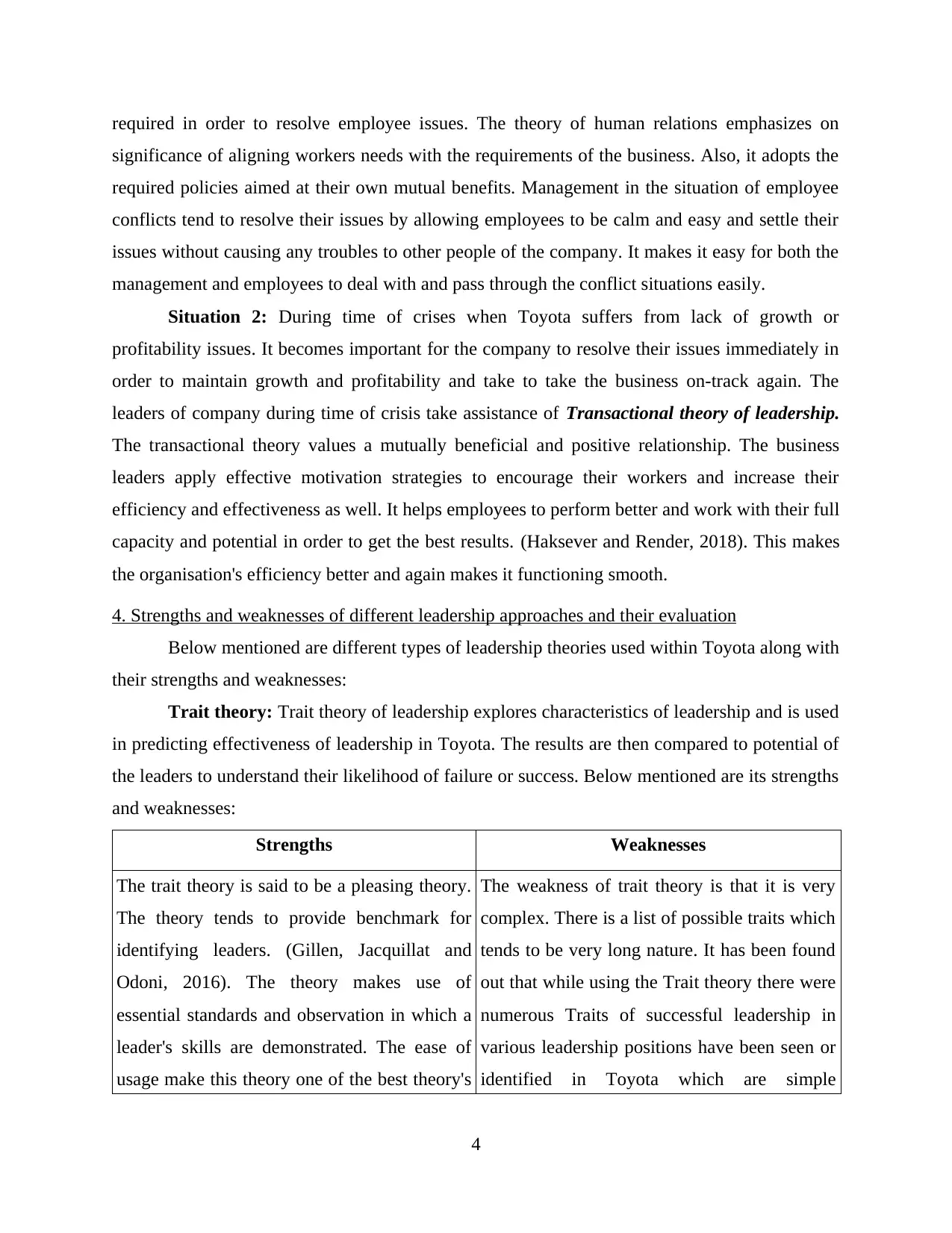
required in order to resolve employee issues. The theory of human relations emphasizes on
significance of aligning workers needs with the requirements of the business. Also, it adopts the
required policies aimed at their own mutual benefits. Management in the situation of employee
conflicts tend to resolve their issues by allowing employees to be calm and easy and settle their
issues without causing any troubles to other people of the company. It makes it easy for both the
management and employees to deal with and pass through the conflict situations easily.
Situation 2: During time of crises when Toyota suffers from lack of growth or
profitability issues. It becomes important for the company to resolve their issues immediately in
order to maintain growth and profitability and take to take the business on-track again. The
leaders of company during time of crisis take assistance of Transactional theory of leadership.
The transactional theory values a mutually beneficial and positive relationship. The business
leaders apply effective motivation strategies to encourage their workers and increase their
efficiency and effectiveness as well. It helps employees to perform better and work with their full
capacity and potential in order to get the best results. (Haksever and Render, 2018). This makes
the organisation's efficiency better and again makes it functioning smooth.
4. Strengths and weaknesses of different leadership approaches and their evaluation
Below mentioned are different types of leadership theories used within Toyota along with
their strengths and weaknesses:
Trait theory: Trait theory of leadership explores characteristics of leadership and is used
in predicting effectiveness of leadership in Toyota. The results are then compared to potential of
the leaders to understand their likelihood of failure or success. Below mentioned are its strengths
and weaknesses:
Strengths Weaknesses
The trait theory is said to be a pleasing theory.
The theory tends to provide benchmark for
identifying leaders. (Gillen, Jacquillat and
Odoni, 2016). The theory makes use of
essential standards and observation in which a
leader's skills are demonstrated. The ease of
usage make this theory one of the best theory's
The weakness of trait theory is that it is very
complex. There is a list of possible traits which
tends to be very long nature. It has been found
out that while using the Trait theory there were
numerous Traits of successful leadership in
various leadership positions have been seen or
identified in Toyota which are simple
4
significance of aligning workers needs with the requirements of the business. Also, it adopts the
required policies aimed at their own mutual benefits. Management in the situation of employee
conflicts tend to resolve their issues by allowing employees to be calm and easy and settle their
issues without causing any troubles to other people of the company. It makes it easy for both the
management and employees to deal with and pass through the conflict situations easily.
Situation 2: During time of crises when Toyota suffers from lack of growth or
profitability issues. It becomes important for the company to resolve their issues immediately in
order to maintain growth and profitability and take to take the business on-track again. The
leaders of company during time of crisis take assistance of Transactional theory of leadership.
The transactional theory values a mutually beneficial and positive relationship. The business
leaders apply effective motivation strategies to encourage their workers and increase their
efficiency and effectiveness as well. It helps employees to perform better and work with their full
capacity and potential in order to get the best results. (Haksever and Render, 2018). This makes
the organisation's efficiency better and again makes it functioning smooth.
4. Strengths and weaknesses of different leadership approaches and their evaluation
Below mentioned are different types of leadership theories used within Toyota along with
their strengths and weaknesses:
Trait theory: Trait theory of leadership explores characteristics of leadership and is used
in predicting effectiveness of leadership in Toyota. The results are then compared to potential of
the leaders to understand their likelihood of failure or success. Below mentioned are its strengths
and weaknesses:
Strengths Weaknesses
The trait theory is said to be a pleasing theory.
The theory tends to provide benchmark for
identifying leaders. (Gillen, Jacquillat and
Odoni, 2016). The theory makes use of
essential standards and observation in which a
leader's skills are demonstrated. The ease of
usage make this theory one of the best theory's
The weakness of trait theory is that it is very
complex. There is a list of possible traits which
tends to be very long nature. It has been found
out that while using the Trait theory there were
numerous Traits of successful leadership in
various leadership positions have been seen or
identified in Toyota which are simple
4
Paraphrase This Document
Need a fresh take? Get an instant paraphrase of this document with our AI Paraphraser
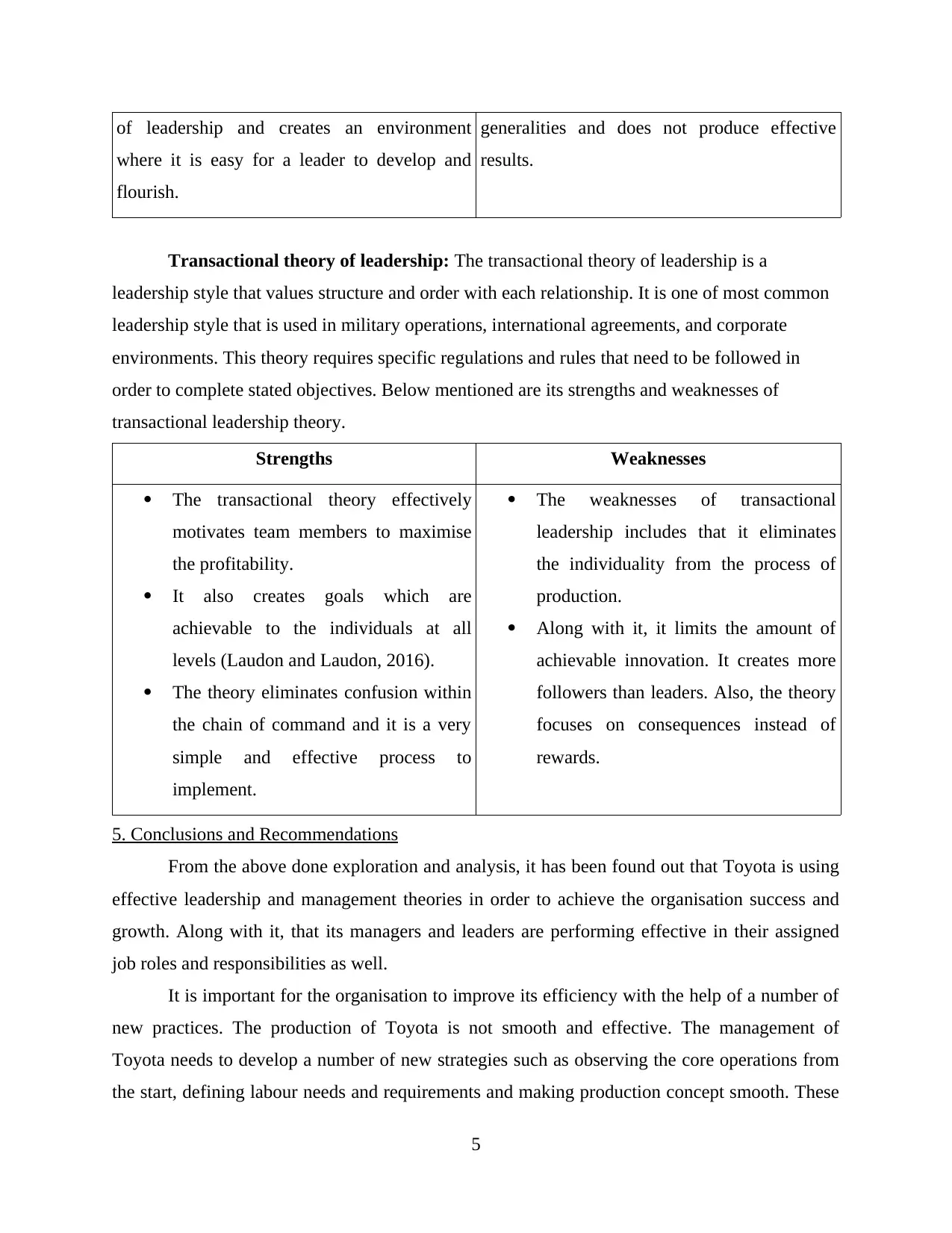
of leadership and creates an environment
where it is easy for a leader to develop and
flourish.
generalities and does not produce effective
results.
Transactional theory of leadership: The transactional theory of leadership is a
leadership style that values structure and order with each relationship. It is one of most common
leadership style that is used in military operations, international agreements, and corporate
environments. This theory requires specific regulations and rules that need to be followed in
order to complete stated objectives. Below mentioned are its strengths and weaknesses of
transactional leadership theory.
Strengths Weaknesses
The transactional theory effectively
motivates team members to maximise
the profitability.
It also creates goals which are
achievable to the individuals at all
levels (Laudon and Laudon, 2016).
The theory eliminates confusion within
the chain of command and it is a very
simple and effective process to
implement.
The weaknesses of transactional
leadership includes that it eliminates
the individuality from the process of
production.
Along with it, it limits the amount of
achievable innovation. It creates more
followers than leaders. Also, the theory
focuses on consequences instead of
rewards.
5. Conclusions and Recommendations
From the above done exploration and analysis, it has been found out that Toyota is using
effective leadership and management theories in order to achieve the organisation success and
growth. Along with it, that its managers and leaders are performing effective in their assigned
job roles and responsibilities as well.
It is important for the organisation to improve its efficiency with the help of a number of
new practices. The production of Toyota is not smooth and effective. The management of
Toyota needs to develop a number of new strategies such as observing the core operations from
the start, defining labour needs and requirements and making production concept smooth. These
5
where it is easy for a leader to develop and
flourish.
generalities and does not produce effective
results.
Transactional theory of leadership: The transactional theory of leadership is a
leadership style that values structure and order with each relationship. It is one of most common
leadership style that is used in military operations, international agreements, and corporate
environments. This theory requires specific regulations and rules that need to be followed in
order to complete stated objectives. Below mentioned are its strengths and weaknesses of
transactional leadership theory.
Strengths Weaknesses
The transactional theory effectively
motivates team members to maximise
the profitability.
It also creates goals which are
achievable to the individuals at all
levels (Laudon and Laudon, 2016).
The theory eliminates confusion within
the chain of command and it is a very
simple and effective process to
implement.
The weaknesses of transactional
leadership includes that it eliminates
the individuality from the process of
production.
Along with it, it limits the amount of
achievable innovation. It creates more
followers than leaders. Also, the theory
focuses on consequences instead of
rewards.
5. Conclusions and Recommendations
From the above done exploration and analysis, it has been found out that Toyota is using
effective leadership and management theories in order to achieve the organisation success and
growth. Along with it, that its managers and leaders are performing effective in their assigned
job roles and responsibilities as well.
It is important for the organisation to improve its efficiency with the help of a number of
new practices. The production of Toyota is not smooth and effective. The management of
Toyota needs to develop a number of new strategies such as observing the core operations from
the start, defining labour needs and requirements and making production concept smooth. These
5
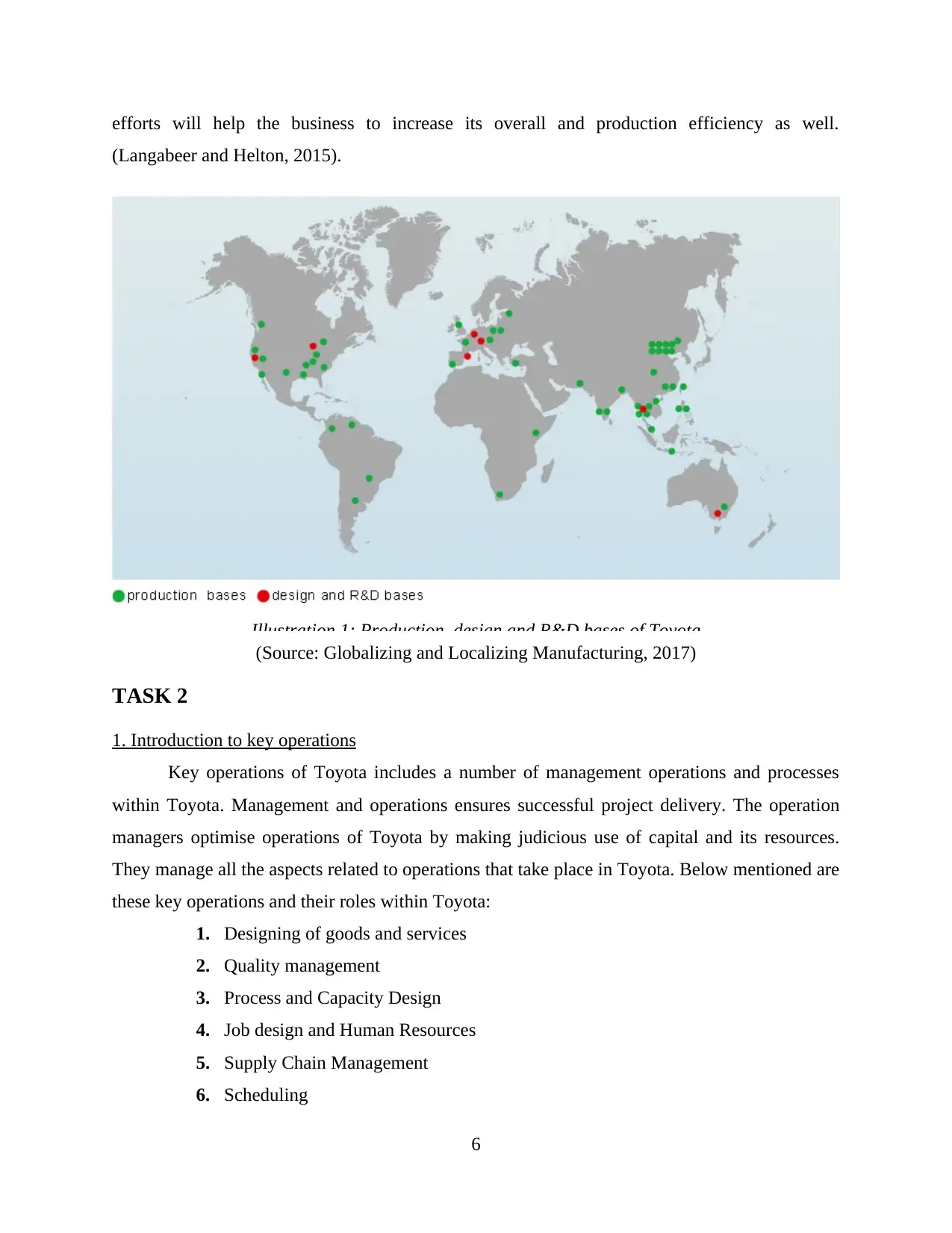
efforts will help the business to increase its overall and production efficiency as well.
(Langabeer and Helton, 2015).
(Source: Globalizing and Localizing Manufacturing, 2017)
TASK 2
1. Introduction to key operations
Key operations of Toyota includes a number of management operations and processes
within Toyota. Management and operations ensures successful project delivery. The operation
managers optimise operations of Toyota by making judicious use of capital and its resources.
They manage all the aspects related to operations that take place in Toyota. Below mentioned are
these key operations and their roles within Toyota:
1. Designing of goods and services
2. Quality management
3. Process and Capacity Design
4. Job design and Human Resources
5. Supply Chain Management
6. Scheduling
6
Illustration 1: Production, design and R&D bases of Toyota
(Langabeer and Helton, 2015).
(Source: Globalizing and Localizing Manufacturing, 2017)
TASK 2
1. Introduction to key operations
Key operations of Toyota includes a number of management operations and processes
within Toyota. Management and operations ensures successful project delivery. The operation
managers optimise operations of Toyota by making judicious use of capital and its resources.
They manage all the aspects related to operations that take place in Toyota. Below mentioned are
these key operations and their roles within Toyota:
1. Designing of goods and services
2. Quality management
3. Process and Capacity Design
4. Job design and Human Resources
5. Supply Chain Management
6. Scheduling
6
Illustration 1: Production, design and R&D bases of Toyota
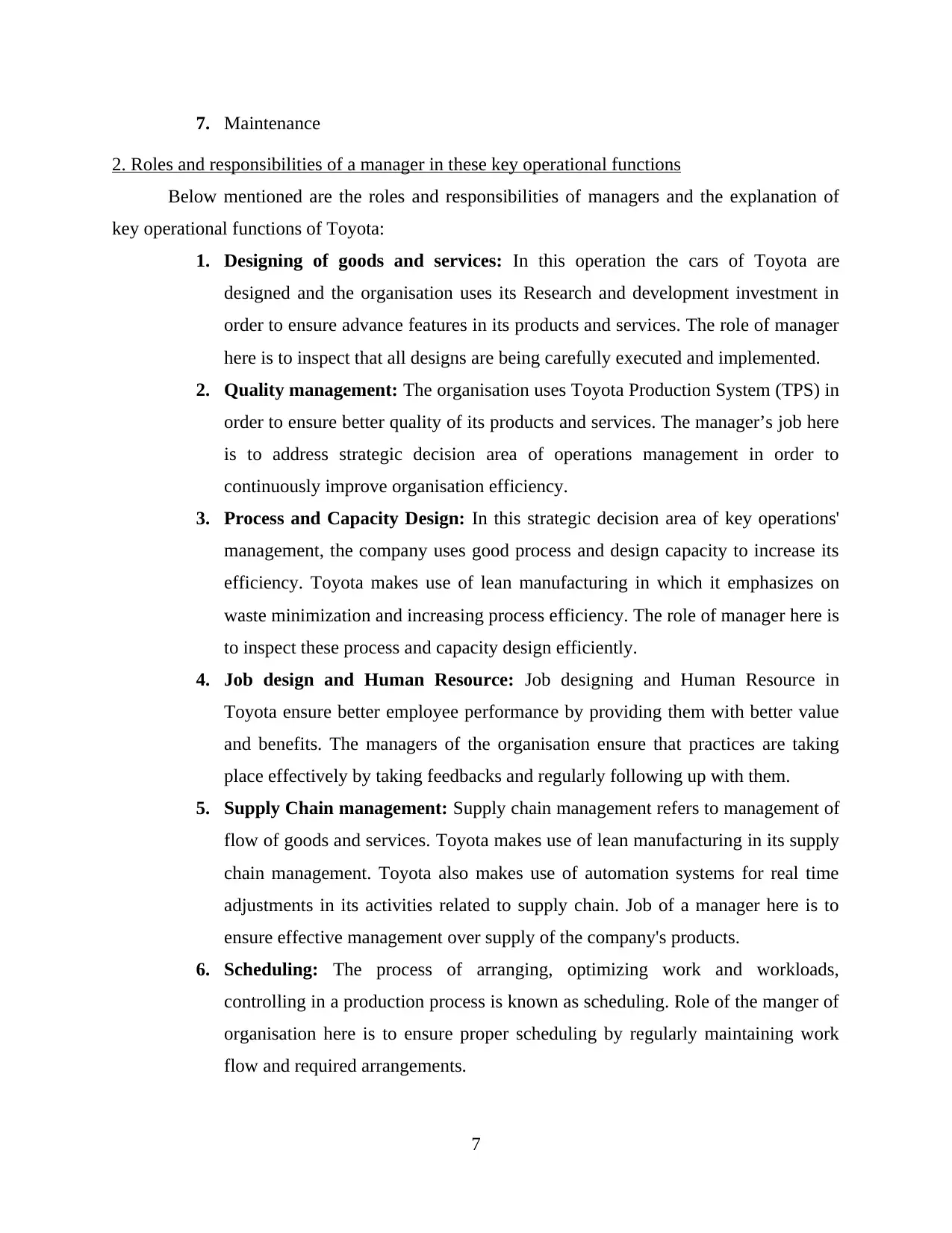
7. Maintenance
2. Roles and responsibilities of a manager in these key operational functions
Below mentioned are the roles and responsibilities of managers and the explanation of
key operational functions of Toyota:
1. Designing of goods and services: In this operation the cars of Toyota are
designed and the organisation uses its Research and development investment in
order to ensure advance features in its products and services. The role of manager
here is to inspect that all designs are being carefully executed and implemented.
2. Quality management: The organisation uses Toyota Production System (TPS) in
order to ensure better quality of its products and services. The manager’s job here
is to address strategic decision area of operations management in order to
continuously improve organisation efficiency.
3. Process and Capacity Design: In this strategic decision area of key operations'
management, the company uses good process and design capacity to increase its
efficiency. Toyota makes use of lean manufacturing in which it emphasizes on
waste minimization and increasing process efficiency. The role of manager here is
to inspect these process and capacity design efficiently.
4. Job design and Human Resource: Job designing and Human Resource in
Toyota ensure better employee performance by providing them with better value
and benefits. The managers of the organisation ensure that practices are taking
place effectively by taking feedbacks and regularly following up with them.
5. Supply Chain management: Supply chain management refers to management of
flow of goods and services. Toyota makes use of lean manufacturing in its supply
chain management. Toyota also makes use of automation systems for real time
adjustments in its activities related to supply chain. Job of a manager here is to
ensure effective management over supply of the company's products.
6. Scheduling: The process of arranging, optimizing work and workloads,
controlling in a production process is known as scheduling. Role of the manger of
organisation here is to ensure proper scheduling by regularly maintaining work
flow and required arrangements.
7
2. Roles and responsibilities of a manager in these key operational functions
Below mentioned are the roles and responsibilities of managers and the explanation of
key operational functions of Toyota:
1. Designing of goods and services: In this operation the cars of Toyota are
designed and the organisation uses its Research and development investment in
order to ensure advance features in its products and services. The role of manager
here is to inspect that all designs are being carefully executed and implemented.
2. Quality management: The organisation uses Toyota Production System (TPS) in
order to ensure better quality of its products and services. The manager’s job here
is to address strategic decision area of operations management in order to
continuously improve organisation efficiency.
3. Process and Capacity Design: In this strategic decision area of key operations'
management, the company uses good process and design capacity to increase its
efficiency. Toyota makes use of lean manufacturing in which it emphasizes on
waste minimization and increasing process efficiency. The role of manager here is
to inspect these process and capacity design efficiently.
4. Job design and Human Resource: Job designing and Human Resource in
Toyota ensure better employee performance by providing them with better value
and benefits. The managers of the organisation ensure that practices are taking
place effectively by taking feedbacks and regularly following up with them.
5. Supply Chain management: Supply chain management refers to management of
flow of goods and services. Toyota makes use of lean manufacturing in its supply
chain management. Toyota also makes use of automation systems for real time
adjustments in its activities related to supply chain. Job of a manager here is to
ensure effective management over supply of the company's products.
6. Scheduling: The process of arranging, optimizing work and workloads,
controlling in a production process is known as scheduling. Role of the manger of
organisation here is to ensure proper scheduling by regularly maintaining work
flow and required arrangements.
7
Secure Best Marks with AI Grader
Need help grading? Try our AI Grader for instant feedback on your assignments.
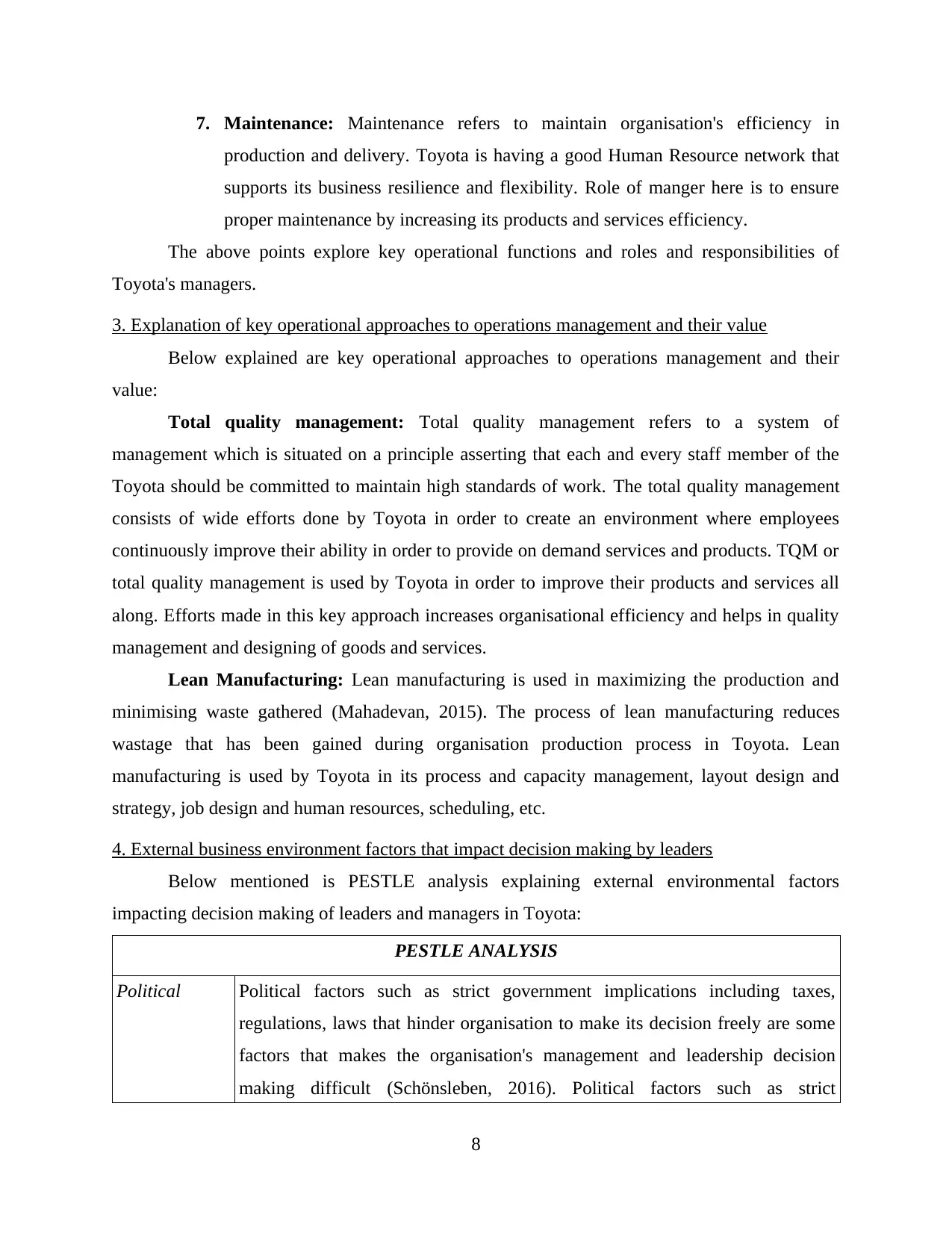
7. Maintenance: Maintenance refers to maintain organisation's efficiency in
production and delivery. Toyota is having a good Human Resource network that
supports its business resilience and flexibility. Role of manger here is to ensure
proper maintenance by increasing its products and services efficiency.
The above points explore key operational functions and roles and responsibilities of
Toyota's managers.
3. Explanation of key operational approaches to operations management and their value
Below explained are key operational approaches to operations management and their
value:
Total quality management: Total quality management refers to a system of
management which is situated on a principle asserting that each and every staff member of the
Toyota should be committed to maintain high standards of work. The total quality management
consists of wide efforts done by Toyota in order to create an environment where employees
continuously improve their ability in order to provide on demand services and products. TQM or
total quality management is used by Toyota in order to improve their products and services all
along. Efforts made in this key approach increases organisational efficiency and helps in quality
management and designing of goods and services.
Lean Manufacturing: Lean manufacturing is used in maximizing the production and
minimising waste gathered (Mahadevan, 2015). The process of lean manufacturing reduces
wastage that has been gained during organisation production process in Toyota. Lean
manufacturing is used by Toyota in its process and capacity management, layout design and
strategy, job design and human resources, scheduling, etc.
4. External business environment factors that impact decision making by leaders
Below mentioned is PESTLE analysis explaining external environmental factors
impacting decision making of leaders and managers in Toyota:
PESTLE ANALYSIS
Political Political factors such as strict government implications including taxes,
regulations, laws that hinder organisation to make its decision freely are some
factors that makes the organisation's management and leadership decision
making difficult (Schönsleben, 2016). Political factors such as strict
8
production and delivery. Toyota is having a good Human Resource network that
supports its business resilience and flexibility. Role of manger here is to ensure
proper maintenance by increasing its products and services efficiency.
The above points explore key operational functions and roles and responsibilities of
Toyota's managers.
3. Explanation of key operational approaches to operations management and their value
Below explained are key operational approaches to operations management and their
value:
Total quality management: Total quality management refers to a system of
management which is situated on a principle asserting that each and every staff member of the
Toyota should be committed to maintain high standards of work. The total quality management
consists of wide efforts done by Toyota in order to create an environment where employees
continuously improve their ability in order to provide on demand services and products. TQM or
total quality management is used by Toyota in order to improve their products and services all
along. Efforts made in this key approach increases organisational efficiency and helps in quality
management and designing of goods and services.
Lean Manufacturing: Lean manufacturing is used in maximizing the production and
minimising waste gathered (Mahadevan, 2015). The process of lean manufacturing reduces
wastage that has been gained during organisation production process in Toyota. Lean
manufacturing is used by Toyota in its process and capacity management, layout design and
strategy, job design and human resources, scheduling, etc.
4. External business environment factors that impact decision making by leaders
Below mentioned is PESTLE analysis explaining external environmental factors
impacting decision making of leaders and managers in Toyota:
PESTLE ANALYSIS
Political Political factors such as strict government implications including taxes,
regulations, laws that hinder organisation to make its decision freely are some
factors that makes the organisation's management and leadership decision
making difficult (Schönsleben, 2016). Political factors such as strict
8

government policies makes it hard for the organisational leaders to make their
decision based on the selling of goods and buying of raw material within a
country's political environment.
Economical Economic factors impacting decision making of leaders and managers include
currency fluctuations, bank strikes, and lack of country's growth in its
development etc. Economic factors such as currency fluctuations make it hard
for the company to sell its cars on the same prices and they have to keep
changing their prices. It impacts the decision making of leaders by
understanding different currency and their fluctuations and making required
decisions as per them.
Social Social factors include changing trends within the community of people which
Toyota is serving. Also, the changing needs and demands of its consumers etc.
impact its leadership and management's decision making (Hitt, Xu and Carnes,
2016). Factors such as changing people's demands makes it hard for the
organisation to keep producing the same kind of products and the leaders have
to make new decision as per these needs and demands.
Technological Technological factors include updation in new technology, better technology
used by its competitors, arrival of better machines and automation etc. These
factors largely impact decision making of its leadership and management.
Arrival of new technology makes it hard for the organisation to keep the same
old technology in place, It makes it hard for the organisation's leaders to make
required decisions based on technology.
Legal Legal factors impacting Toyota's decision making include strict laws which
makes it hard for the organisation to operate freely. Also, strict legal
implication on its products sales in other countries also makes it hard for the
organisations leaders and managers to make decisions. Such as strong
implications on selling of its cars and heavy taxes makes the organisation's
managers and leaders decision making difficult. The leaders of the organisation
has to be aware of the what policies and legal uniformities they are dealing with
9
decision based on the selling of goods and buying of raw material within a
country's political environment.
Economical Economic factors impacting decision making of leaders and managers include
currency fluctuations, bank strikes, and lack of country's growth in its
development etc. Economic factors such as currency fluctuations make it hard
for the company to sell its cars on the same prices and they have to keep
changing their prices. It impacts the decision making of leaders by
understanding different currency and their fluctuations and making required
decisions as per them.
Social Social factors include changing trends within the community of people which
Toyota is serving. Also, the changing needs and demands of its consumers etc.
impact its leadership and management's decision making (Hitt, Xu and Carnes,
2016). Factors such as changing people's demands makes it hard for the
organisation to keep producing the same kind of products and the leaders have
to make new decision as per these needs and demands.
Technological Technological factors include updation in new technology, better technology
used by its competitors, arrival of better machines and automation etc. These
factors largely impact decision making of its leadership and management.
Arrival of new technology makes it hard for the organisation to keep the same
old technology in place, It makes it hard for the organisation's leaders to make
required decisions based on technology.
Legal Legal factors impacting Toyota's decision making include strict laws which
makes it hard for the organisation to operate freely. Also, strict legal
implication on its products sales in other countries also makes it hard for the
organisations leaders and managers to make decisions. Such as strong
implications on selling of its cars and heavy taxes makes the organisation's
managers and leaders decision making difficult. The leaders of the organisation
has to be aware of the what policies and legal uniformities they are dealing with
9
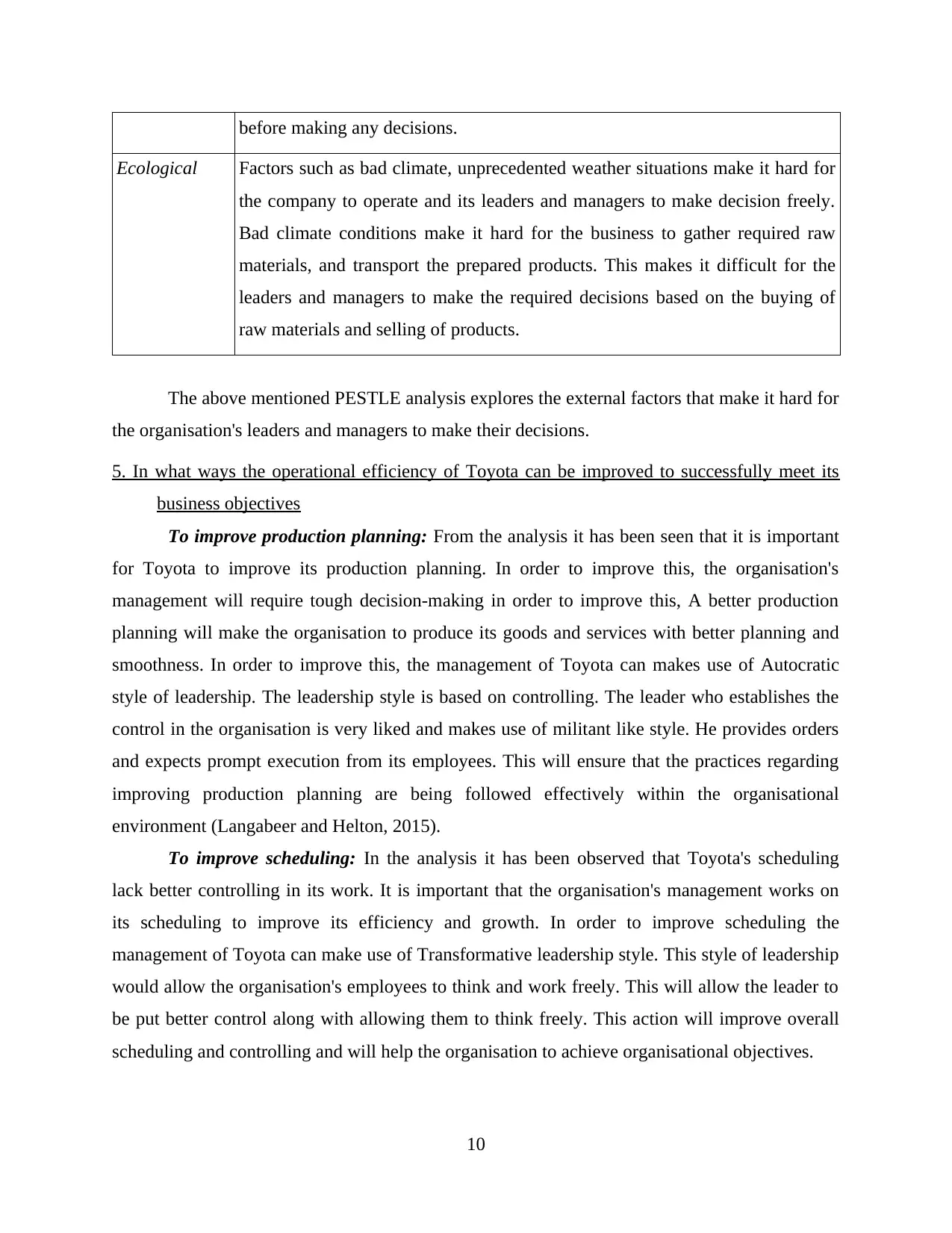
before making any decisions.
Ecological Factors such as bad climate, unprecedented weather situations make it hard for
the company to operate and its leaders and managers to make decision freely.
Bad climate conditions make it hard for the business to gather required raw
materials, and transport the prepared products. This makes it difficult for the
leaders and managers to make the required decisions based on the buying of
raw materials and selling of products.
The above mentioned PESTLE analysis explores the external factors that make it hard for
the organisation's leaders and managers to make their decisions.
5. In what ways the operational efficiency of Toyota can be improved to successfully meet its
business objectives
To improve production planning: From the analysis it has been seen that it is important
for Toyota to improve its production planning. In order to improve this, the organisation's
management will require tough decision-making in order to improve this, A better production
planning will make the organisation to produce its goods and services with better planning and
smoothness. In order to improve this, the management of Toyota can makes use of Autocratic
style of leadership. The leadership style is based on controlling. The leader who establishes the
control in the organisation is very liked and makes use of militant like style. He provides orders
and expects prompt execution from its employees. This will ensure that the practices regarding
improving production planning are being followed effectively within the organisational
environment (Langabeer and Helton, 2015).
To improve scheduling: In the analysis it has been observed that Toyota's scheduling
lack better controlling in its work. It is important that the organisation's management works on
its scheduling to improve its efficiency and growth. In order to improve scheduling the
management of Toyota can make use of Transformative leadership style. This style of leadership
would allow the organisation's employees to think and work freely. This will allow the leader to
be put better control along with allowing them to think freely. This action will improve overall
scheduling and controlling and will help the organisation to achieve organisational objectives.
10
Ecological Factors such as bad climate, unprecedented weather situations make it hard for
the company to operate and its leaders and managers to make decision freely.
Bad climate conditions make it hard for the business to gather required raw
materials, and transport the prepared products. This makes it difficult for the
leaders and managers to make the required decisions based on the buying of
raw materials and selling of products.
The above mentioned PESTLE analysis explores the external factors that make it hard for
the organisation's leaders and managers to make their decisions.
5. In what ways the operational efficiency of Toyota can be improved to successfully meet its
business objectives
To improve production planning: From the analysis it has been seen that it is important
for Toyota to improve its production planning. In order to improve this, the organisation's
management will require tough decision-making in order to improve this, A better production
planning will make the organisation to produce its goods and services with better planning and
smoothness. In order to improve this, the management of Toyota can makes use of Autocratic
style of leadership. The leadership style is based on controlling. The leader who establishes the
control in the organisation is very liked and makes use of militant like style. He provides orders
and expects prompt execution from its employees. This will ensure that the practices regarding
improving production planning are being followed effectively within the organisational
environment (Langabeer and Helton, 2015).
To improve scheduling: In the analysis it has been observed that Toyota's scheduling
lack better controlling in its work. It is important that the organisation's management works on
its scheduling to improve its efficiency and growth. In order to improve scheduling the
management of Toyota can make use of Transformative leadership style. This style of leadership
would allow the organisation's employees to think and work freely. This will allow the leader to
be put better control along with allowing them to think freely. This action will improve overall
scheduling and controlling and will help the organisation to achieve organisational objectives.
10
Paraphrase This Document
Need a fresh take? Get an instant paraphrase of this document with our AI Paraphraser
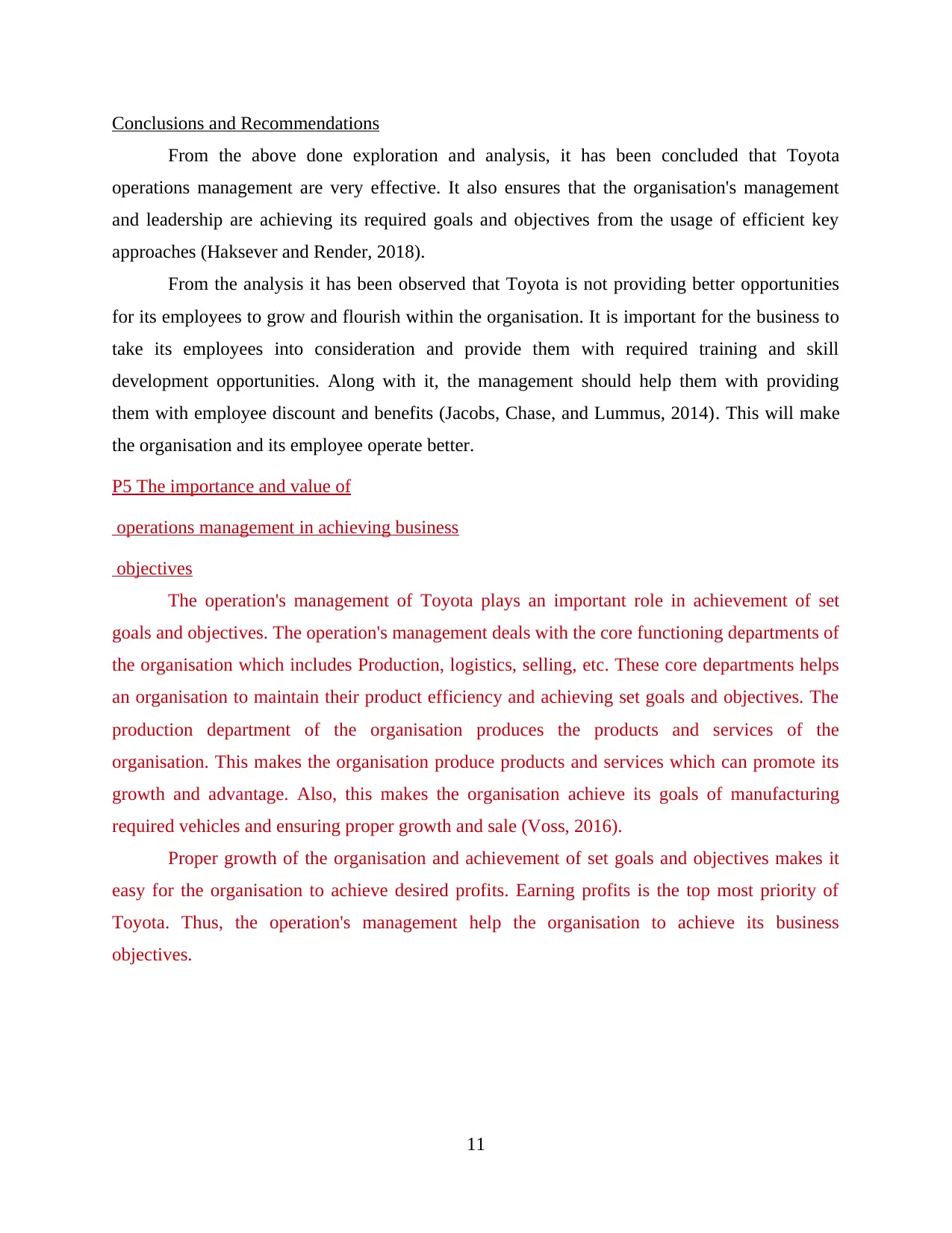
Conclusions and Recommendations
From the above done exploration and analysis, it has been concluded that Toyota
operations management are very effective. It also ensures that the organisation's management
and leadership are achieving its required goals and objectives from the usage of efficient key
approaches (Haksever and Render, 2018).
From the analysis it has been observed that Toyota is not providing better opportunities
for its employees to grow and flourish within the organisation. It is important for the business to
take its employees into consideration and provide them with required training and skill
development opportunities. Along with it, the management should help them with providing
them with employee discount and benefits (Jacobs, Chase, and Lummus, 2014). This will make
the organisation and its employee operate better.
P5 The importance and value of
operations management in achieving business
objectives
The operation's management of Toyota plays an important role in achievement of set
goals and objectives. The operation's management deals with the core functioning departments of
the organisation which includes Production, logistics, selling, etc. These core departments helps
an organisation to maintain their product efficiency and achieving set goals and objectives. The
production department of the organisation produces the products and services of the
organisation. This makes the organisation produce products and services which can promote its
growth and advantage. Also, this makes the organisation achieve its goals of manufacturing
required vehicles and ensuring proper growth and sale (Voss, 2016).
Proper growth of the organisation and achievement of set goals and objectives makes it
easy for the organisation to achieve desired profits. Earning profits is the top most priority of
Toyota. Thus, the operation's management help the organisation to achieve its business
objectives.
11
From the above done exploration and analysis, it has been concluded that Toyota
operations management are very effective. It also ensures that the organisation's management
and leadership are achieving its required goals and objectives from the usage of efficient key
approaches (Haksever and Render, 2018).
From the analysis it has been observed that Toyota is not providing better opportunities
for its employees to grow and flourish within the organisation. It is important for the business to
take its employees into consideration and provide them with required training and skill
development opportunities. Along with it, the management should help them with providing
them with employee discount and benefits (Jacobs, Chase, and Lummus, 2014). This will make
the organisation and its employee operate better.
P5 The importance and value of
operations management in achieving business
objectives
The operation's management of Toyota plays an important role in achievement of set
goals and objectives. The operation's management deals with the core functioning departments of
the organisation which includes Production, logistics, selling, etc. These core departments helps
an organisation to maintain their product efficiency and achieving set goals and objectives. The
production department of the organisation produces the products and services of the
organisation. This makes the organisation produce products and services which can promote its
growth and advantage. Also, this makes the organisation achieve its goals of manufacturing
required vehicles and ensuring proper growth and sale (Voss, 2016).
Proper growth of the organisation and achievement of set goals and objectives makes it
easy for the organisation to achieve desired profits. Earning profits is the top most priority of
Toyota. Thus, the operation's management help the organisation to achieve its business
objectives.
11

P6 The factors within the business
environment that impact upon operational
management and decision-making by leaders
and managers
Below mentioned are both the Internal and External factors which impact the decision
making by organisation's leaders:
Internal
Internal factors such as corporate culture of the organisation ensures proper
organisational efficiency and effectiveness. The corporate culture of the organisation ensure that
the organisation's culture and environment is positive and serving the needs of its stakeholder. A
better corporate culture deals with having an effective and efficient management. Also, it ensures
that the employees within the organisational environment are serving their roles properly. None
of the employees are facing troubles related to any causes and the operations are smooth and
efficient. The culture of the organisation impacts decision making as when the culture is positive
the decisions of the organisations get easy. A negative culture makes it hard for the leader and
managers to make appropriate decisions for the organisational growth (Haksever and Render,
2018).
Corporate value and ethics is another factor that impact the business environment of the
organisation. The right values ensure that the organisation is achieving right objectives and
goals. Also, these value ensure that the organisation is achieving set goals and objectives
properly and is rooted to its set needs.
Right ethics ensure that the business environment of the organisation is efficient and
smooth. The ethics make the organisation pillars and its culture strong and efficient. It makes it
easy for the organisation to achieve its desired outcomes.
Having a better corporate value allows the organisation's leader and managers to create
decisions which can add up its profitability and growth. Also, right ethics always help the
management and leadership to make their decisions in favours without much struggle.
External
Below mentioned is PEST analysis exploring the external environmental factors
impacting the decision making of the organisation:
12
environment that impact upon operational
management and decision-making by leaders
and managers
Below mentioned are both the Internal and External factors which impact the decision
making by organisation's leaders:
Internal
Internal factors such as corporate culture of the organisation ensures proper
organisational efficiency and effectiveness. The corporate culture of the organisation ensure that
the organisation's culture and environment is positive and serving the needs of its stakeholder. A
better corporate culture deals with having an effective and efficient management. Also, it ensures
that the employees within the organisational environment are serving their roles properly. None
of the employees are facing troubles related to any causes and the operations are smooth and
efficient. The culture of the organisation impacts decision making as when the culture is positive
the decisions of the organisations get easy. A negative culture makes it hard for the leader and
managers to make appropriate decisions for the organisational growth (Haksever and Render,
2018).
Corporate value and ethics is another factor that impact the business environment of the
organisation. The right values ensure that the organisation is achieving right objectives and
goals. Also, these value ensure that the organisation is achieving set goals and objectives
properly and is rooted to its set needs.
Right ethics ensure that the business environment of the organisation is efficient and
smooth. The ethics make the organisation pillars and its culture strong and efficient. It makes it
easy for the organisation to achieve its desired outcomes.
Having a better corporate value allows the organisation's leader and managers to create
decisions which can add up its profitability and growth. Also, right ethics always help the
management and leadership to make their decisions in favours without much struggle.
External
Below mentioned is PEST analysis exploring the external environmental factors
impacting the decision making of the organisation:
12
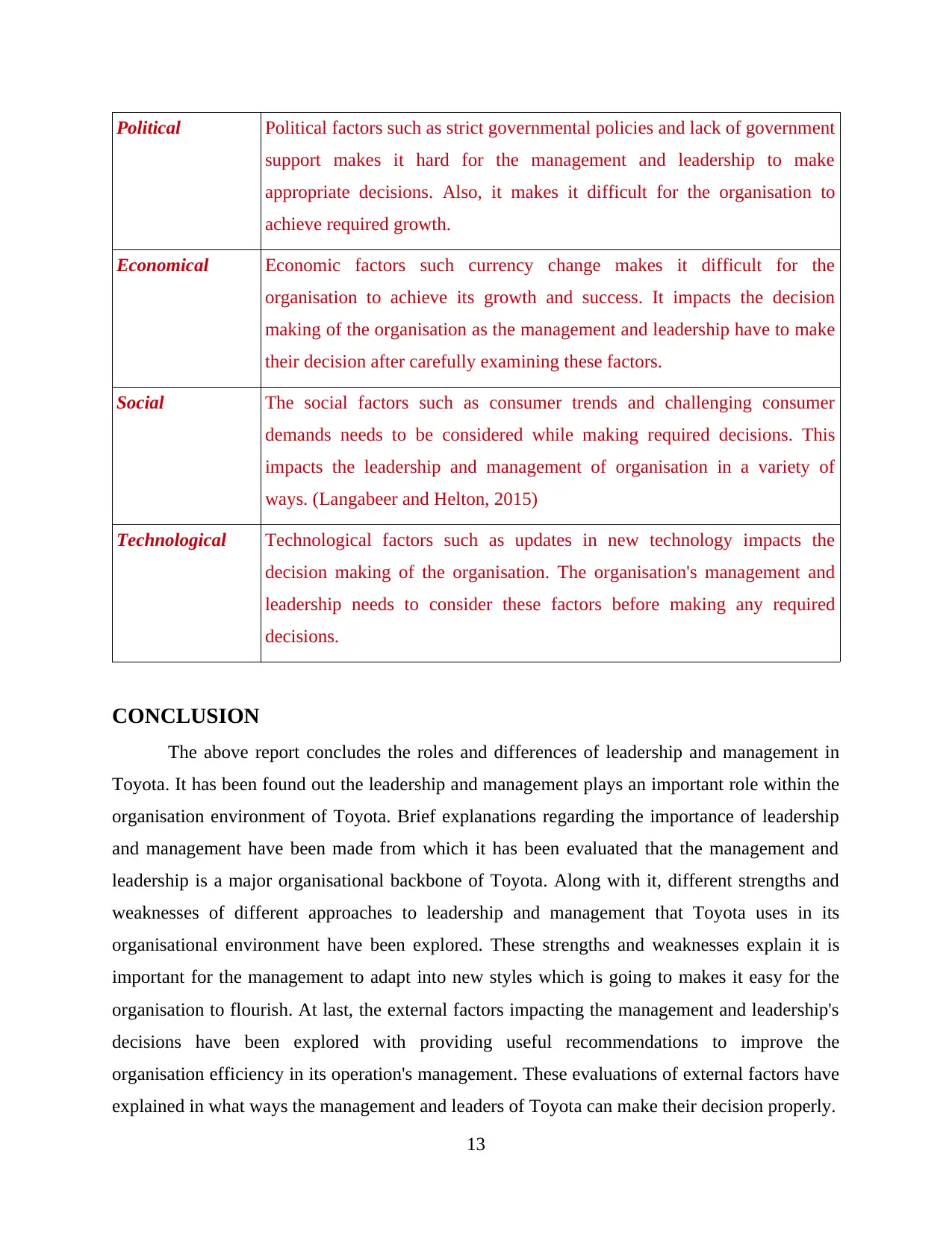
Political Political factors such as strict governmental policies and lack of government
support makes it hard for the management and leadership to make
appropriate decisions. Also, it makes it difficult for the organisation to
achieve required growth.
Economical Economic factors such currency change makes it difficult for the
organisation to achieve its growth and success. It impacts the decision
making of the organisation as the management and leadership have to make
their decision after carefully examining these factors.
Social The social factors such as consumer trends and challenging consumer
demands needs to be considered while making required decisions. This
impacts the leadership and management of organisation in a variety of
ways. (Langabeer and Helton, 2015)
Technological Technological factors such as updates in new technology impacts the
decision making of the organisation. The organisation's management and
leadership needs to consider these factors before making any required
decisions.
CONCLUSION
The above report concludes the roles and differences of leadership and management in
Toyota. It has been found out the leadership and management plays an important role within the
organisation environment of Toyota. Brief explanations regarding the importance of leadership
and management have been made from which it has been evaluated that the management and
leadership is a major organisational backbone of Toyota. Along with it, different strengths and
weaknesses of different approaches to leadership and management that Toyota uses in its
organisational environment have been explored. These strengths and weaknesses explain it is
important for the management to adapt into new styles which is going to makes it easy for the
organisation to flourish. At last, the external factors impacting the management and leadership's
decisions have been explored with providing useful recommendations to improve the
organisation efficiency in its operation's management. These evaluations of external factors have
explained in what ways the management and leaders of Toyota can make their decision properly.
13
support makes it hard for the management and leadership to make
appropriate decisions. Also, it makes it difficult for the organisation to
achieve required growth.
Economical Economic factors such currency change makes it difficult for the
organisation to achieve its growth and success. It impacts the decision
making of the organisation as the management and leadership have to make
their decision after carefully examining these factors.
Social The social factors such as consumer trends and challenging consumer
demands needs to be considered while making required decisions. This
impacts the leadership and management of organisation in a variety of
ways. (Langabeer and Helton, 2015)
Technological Technological factors such as updates in new technology impacts the
decision making of the organisation. The organisation's management and
leadership needs to consider these factors before making any required
decisions.
CONCLUSION
The above report concludes the roles and differences of leadership and management in
Toyota. It has been found out the leadership and management plays an important role within the
organisation environment of Toyota. Brief explanations regarding the importance of leadership
and management have been made from which it has been evaluated that the management and
leadership is a major organisational backbone of Toyota. Along with it, different strengths and
weaknesses of different approaches to leadership and management that Toyota uses in its
organisational environment have been explored. These strengths and weaknesses explain it is
important for the management to adapt into new styles which is going to makes it easy for the
organisation to flourish. At last, the external factors impacting the management and leadership's
decisions have been explored with providing useful recommendations to improve the
organisation efficiency in its operation's management. These evaluations of external factors have
explained in what ways the management and leaders of Toyota can make their decision properly.
13
Secure Best Marks with AI Grader
Need help grading? Try our AI Grader for instant feedback on your assignments.

14
1 out of 17
Related Documents
Your All-in-One AI-Powered Toolkit for Academic Success.
+13062052269
info@desklib.com
Available 24*7 on WhatsApp / Email
![[object Object]](/_next/static/media/star-bottom.7253800d.svg)
Unlock your academic potential
© 2024 | Zucol Services PVT LTD | All rights reserved.





